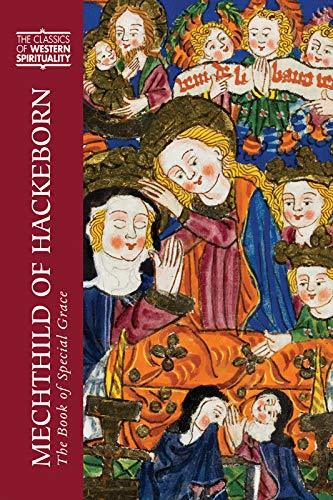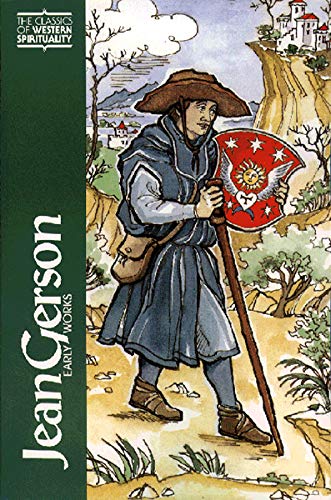


Books in series
Meister Eckhart
The Essential Sermons, Commentaries, Treatises, and Defense
1981

Ibn 'Abbād of Ronda
Letters on the Sufi Path
1986

Jacob Boehme
The Way to Christ
1624

Mechthild of Hackeborn
The Book of Special Grace
2017

Late Medieval Mysticism of the Low Countries (Classics of Western Spirituality
2008

Sharafuddin Maneri
The Hundred Letters
1979

Bezels of Wisdom
1981

Menahem Nahum of Chernobyl
Upright Practices, The Light of the Eyes
1982

Hadewijch
The Complete Works
1980

The Complete Works
530
The Early Kabbalah
The Classics of Western Spirituality
1986

Emanuel Swedenborg
The Universal Human and Soul-Body Interaction
1984

The Shakers
Two Centuries of Spiritual Reflection (Classics of Western Spirituality
1983

Ladder of Perfection
1975

Isaiah Horowitz
The Generations of Adam (Classics of Western Spirituality
1995

Isaiah Horowitz
The Generations of Adam
1995

Elijah Benamozegh
Israel and Humanity
1995

ʿUmar Ibn al-Fārid
Sufi Verse, Saintly Life (Classics of Western Spirituality
2001

Jean Gerson
Early Works (Classics of Western Spirituality
1998

Jean Gerson
Early Works (Classics of Western Spirituality
1998

Norbert and Early Norbertine Spirituality (Classics of Western Spirituality
2007

Abū al-Hasan al-Shushtarī
Songs of Love and Devotion (Classics of Western Spirituality
2009

Muslim Saints and Mystics
Episodes from the Tadhkirat Al-Auliya
1220
Authors

Jean Charlier de Gerson (13 December 1363 – 12 July 1429) was a French scholar, educator, reformer, and poet, Chancellor of the University of Paris, a guiding light of the conciliar movement and one of the most prominent theologians at the Council of Constance. Aged fourteen, he left Gerson-lès-Barby to study at the college of Navarre in Paris under Gilles Deschamps, (Aegidius Campensis) and Pierre d'Ailly (Petrus de Alliaco), who became his life-long friend.

Note to arabic readers : For the original arabic version of the books, check "other editions" in the book that interests you) Universally known by the title of "Muhyi al-Din" (The Reviver of the Religion) and "al-Shaykh al-Akbar" (The Greatest Shaykh) Ibn 'Arabī (Arabic: ابن عربي) (July 28, 1165 - November 10, 1240) was an Arab Sufi Muslim mystic and philosopher. His full name was Abū 'Abdullāh Muḥammad ibn 'Alī ibn Muḥammad ibn al-`Arabī al-Hāṭimī al-Ṭā'ī (أبو عبد الله محمد بن علي بن محمد بن العربي الحاتمي الطائي). Muhammad ibn al-Arabi and his family moved to Seville when he was eight years old. In 1200 CE, at the age of thirty-five, he left Iberia for good, intending to make the hajj to Mecca. He lived in Mecca for some three years, where he began writing his Al-Futūḥāt al-Makkiyya (The Meccan Illuminations). In 1204, he left Mecca for Anatolia with Majd al-Dīn Isḥāq, whose son Ṣadr al-Dīn al-Qunawī (1210-1274) would be his most influential disciple. In 1223, he settled in Damascus, where he lived the last seventeen years of his life. He died at the age of 76 on 22 Rabi' II 638 AH/November 10, 1240CE, and his tomb in Damascus is still an important place of pilgrimage. A vastly prolific writer, Ibn 'Arabī is generally known as the prime exponent of the idea later known as Waḥdat al-Wujūd (literally Unity of Being), though he did not use this term in his writings. His emphasis was on the true potential of the human being and the path to realising that potential and becoming the perfect or complete man (al-insān al-kāmil). Some 800 works are attributed to Ibn 'Arabā, although only some have been authenticated. Recent research suggests that over 100 of his works have survived in manuscript form, although most printed versions have not yet been critically edited and include many errors.


Ibn Al Farid ابن الفارض، هو أبو حفص شرف الدين عمر بن علي بن مرشد الحموي، من حماة في سوريا، أحد أشهر الشعراء المتصوفين، وكانت أشعاره غالبها في العشق الإلهي حتى أنه لقب بـ "سلطان العاشقين". ولد بمصر سنة 576 هـ الموافق 1181م. ولما شب اشتغل بفقه الشافعية، وأخذ الحديث عن ابن عساكر. ثم سلك طريق الصوفية ومال إلى الزهد. رحل إلى مكة في غير أشهر الحج، واعتزل في واد بعيد عنها. وفي عزلته تلك نظم معظم أشعاره في الحب الإلهي، حتى عاد إلى مصر بعد خمسة عشر عامًا. توفي سنة 632 هـ الموافق 1235م في مصر ودفن بجوار جبل المقطم في مسجده المشهور.



The poetry of Shaykh Umar Ibn al-Farid is considered by many to be the pinnacle of Arabic mystical verse (Rumi, probably the best known in the West of the great Sufi poets, wrote primarily in Persian, not Arabic.) Ibn al-Farid's two masterpieces are The Wine Ode, a beautiful meditation on the "wine" of divine bliss, and "The Poem of the Sufi Way", a profound exploration of spiritual experience along the Sufi Path and perhaps the longest mystical poem composed in Arabic. Both poems have inspired in-depth spiritual commentaries throughout the centuries, and they are still reverently memorized by Sufis and other devout Muslims today. He was born in Cairo to parents from Hama in Syria, lived for some time in Mecca, and died in Cairo. His poetry is entirely Sufic and he was esteemed as the greatest mystic poet of the Arabs. Some of his poems are said to have been written in ecstasies. Every Friday, Cairenes gather at his tomb to listen to readings of his poems. Ibn al-Farid is referred to as sultan al-ashiqin, "the sultan of lovers".

Eckhart von Hochheim, commonly known as Meister Eckhart, was a German theologian, philosopher and mystic, born near Gotha, in Thuringia. Meister is German for "Master", referring to the academic title Magister in theologia he obtained in Paris. Coming into prominence during the decadent Avignon Papacy and a time of increased tensions between the Franciscans and Eckhart's Dominican Order of Preacher Friars, he was brought up on charges later in life before the local Franciscan-led Inquisition. Tried as a heretic by Pope John XXII, his "Defence" is famous for his reasoned arguments to all challenged articles of his writing and his refutation of heretical intent. He purportedly died before his verdict was received, although no record of his death or burial site has ever been discovered. Meister Eckhart is sometimes (erroneously) referred to as "Johannes Eckhart", although Eckhart was his given name and von Hochheim was his surname. "Perhaps no mystic in the history of Christianity has been more influential and more controversial than the Dominican Meister Eckart. Few, if any, mystics have been as challenging to modern day readers and as resistant to agreed-upon interpretation." —Bernard McGinn, The Mystical Thought of Meister Eckhart
